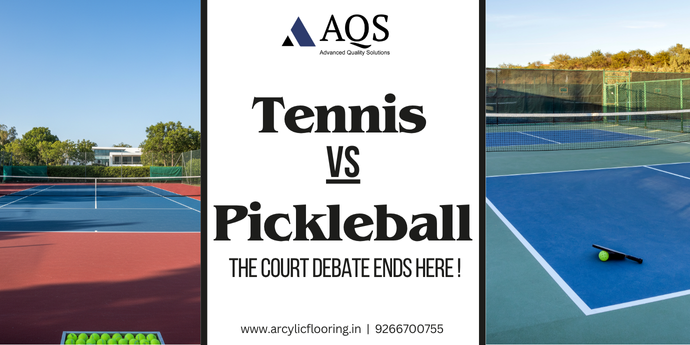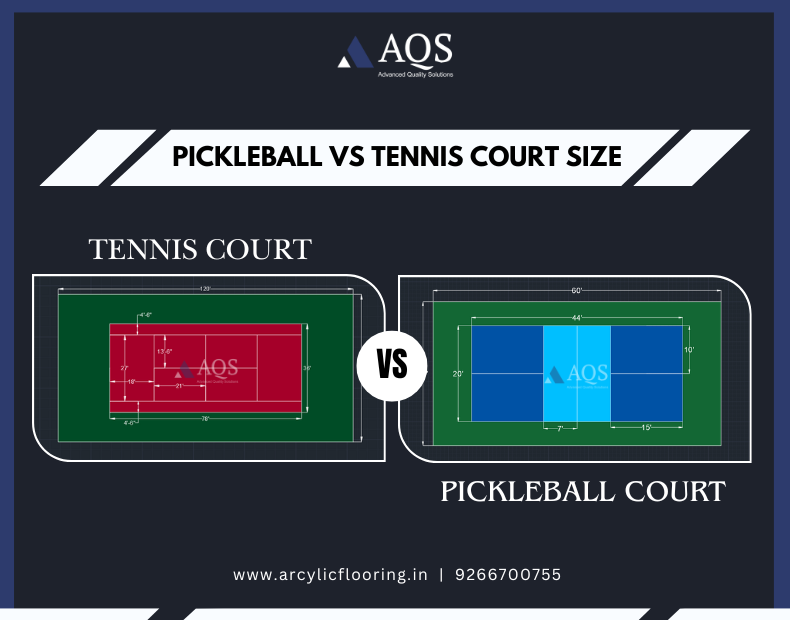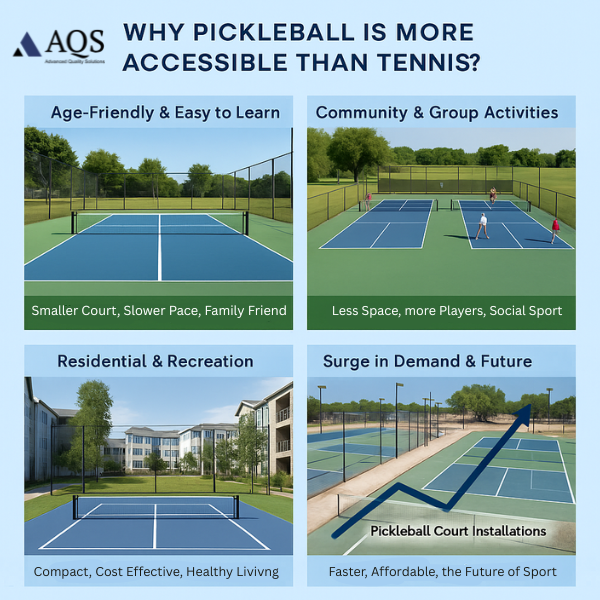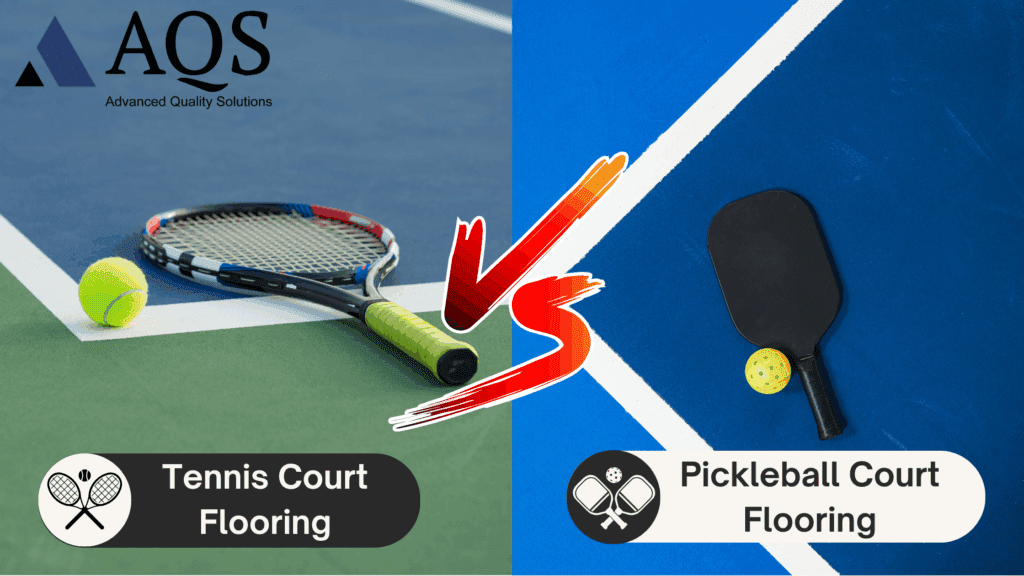
Pickleball is no longer just a US trend, it’s a rage in India too. From schools and housing complexes to private clubs and corporate campuses, the demand for pickleball court construction has increased in just a few years. The beauty of the game lies in its simplicity: it’s a mix of tennis, badminton and table tennis but requires less space, lower investment and is easier to learn.
Tennis courts always dominated recreational and competitive spaces today more communities are asking the same question “Why pickleball instead of tennis?” The answer lies in accessibility, cost and adaptability. A pickleball court floor requires less area, construction costs are lower and the game is friendly for all age groups from kids to seniors. Tennis demands larger playing areas and more physical endurance, pickleball is designed to be inclusive.
This growing demand has created a huge demand for pickleball court flooring material and professional pickleball court builders who can deliver world class installations. For many institutions and homeowners the choice between building a tennis court or a pickleball court comes down to long term investment value and pickleball often wins.
Pickleball Court vs Tennis Court Size

- Pickleball court size is 20×44, tennis court is 36×78 that’s a big difference! The smaller size means lower cost, less space and more accessible to all ages.
- So pickleball courts are much smaller, perfect for small spaces, backyards and housing complexes.Because of the smaller size, pickleball courts can be built where tennis courts can’t. That’s why they are ideal for schools, residential societies and homeowners who want a professional sports setup without large land requirement.
- In fact, 4 pickleball courts can fit into 1 tennis court that’s why many facilities are converting tennis spaces into pickleball courts.
- This multi-use advantage maximizes land space more players can play at the same time. Clubs and academies prefer this conversion because it creates community engagement, generates more revenue and adapts to the current sports trend.
Pickleball vs Tennis Courts – What’s the Difference?
The short answer is no but that’s an understatement. On the surface they might seem the same, but trust us, they’re not. Here are the key differences:
- Surface: What’s Underfoot – Both sports use acrylic coating but pickleball courts need a lighter touch and super-grippy surface so you can run around without slipping and sliding all over the place. Great for all ages no matter how young or old you are. Tennis courts are built for speed and endurance so balls can fly past you at breakneck pace without wearing down too quickly.
- Markings & Rules – Tennis courts are all about the lines: baseline, service lines, singles and doubles sideline it’s a whole different game. Pickleball courts mess with the rules by introducing that no-volley zone everyone calls the “kitchen” where you basically can’t wander into the net and make some wild shot. That changes up both the strategy and the pace of the game.
- Court Size: A Key Difference – While tennis courts are big and in it for a big backyard or city park, they take up a lot more space and require a lot more digging standard pickleball courts are 20 x 44 feet which is just a tiny fraction of the 36 x 78 feet that tennis courts are. That makes them a lot easier to set up in a school or club, or let’s be honest even in your own backyard!
Pickleball Court Cost
When it comes to pickleball court installation, cost is the key factor. Compared to tennis courts, pickleball is more budget friendly:
- Base (concrete/asphalt): Since a pickleball court is smaller than a tennis court, the base requires less excavation, material and time. This directly reduces civil costs and makes sure proper slope and drainage. For homeowners, it makes building a home pickleball court more practical.
- Acrylic system layers: AQS offers premium pickleball court surface solutions, from economical 5-layer systems to cushioned multi-layer coatings. These layers enhance ball bounce, reduce joint impact and make sure long term playability under heavy usage.
- Paint for pickleball court: High quality, UV stable acrylic paint is used for pickleball court flooring to protect against sun damage and color fading. This makes sure the surface remains vibrant, non-slip and durable even under harsh Indian climate.
- Labor & Installation: Smaller footprint of a pickleball court means faster installation compared to tennis courts. With AQS expertise projects are completed on time with minimal disruption, making it cost effective for schools, clubs and housing societies.
On an average the cost of pickleball court is much lower, making it attractive for institutions, communities and private homeowners looking for a long term, low maintenance investment.
Pickleball Flooring – Choosing the Right Material for Your Game
Getting the right surface for pickleball court flooring goes beyond aesthetics; it ensures longevity, player safety, and consistent play. AQS designs synthetic acrylic systems specifically for the Indian climate, striking the perfect balance between durability and playability.
Acrylic Cushioning Systems: Multi-layer coated floors actively reduce the impact on joints and muscles, making long practice sessions less stressful. They also enhance comfort, allowing players of all ages to enjoy the game more fully.
UV-Resistant Flooring: These floors resist fading and surface damage under intense sunlight. They keep pickleball courts looking new and performing consistently, no matter how harsh the weather gets.
Indoors or Outdoors – Always Covered: AQS systems adapt easily to any setup—school gyms, sports clubs, or residential community courts. They consistently deliver the same grip, bounce, and safety, encouraging more people to play.
Long-Lasting Coatings for Every Court: AQS treats every pickleball court flooring with high-quality acrylic coatings that resist slips, withstand weather, and last for years. These coatings make the game safer, lower maintenance costs, and provide a cost-effective long-term investment.
Making A Home Pickleball Court
Private players are rapidly building their own pickleball courts at home. Its compact size lets them set up a court in their backyard or any small recreational space without spending heavily or requiring as much land as a tennis court. Homeowners and housing associations are now putting pickleball court flooring in as a way to make fitness and leisure more accessible and fun without breaking the bank.
- Backyard pickleball court dimensions: A regular backyard pickleball court is 20 feet by 44 feet, which is roughly 880 square feet. With a little bit of clever planning you can fit a proper court in a relatively small space, which makes it perfect for those who have limited room to play with. Just make sure you get the pickleball court surface right, and you can turn even the tiniest of areas into a top notch court.
- Half court pickleball court dimensions: If you just want to practice or have a casual knockabout with mates, a half court is a great option – its smaller size means you can play safely without having to worry about splintering your neighbour’s fence or overwhelming your local park. And best of all, it gives you a chance to get a taste for the game without feeling like you need an acre of land to play on.
- How much space do you need for a pickleball court? A standard pickleball court is roughly 880 sq. ft, which is loads less than a tennis court which needs over 2,800 sq. ft. That’s got to make it a no-brainer for building a court at home, or at your kid’s school, or even at your community center.
Why Pickleball is More Accessible than Tennis?

Pickleball is more age friendly due to its smaller court and slower pace. Tennis requires more endurance and strength, pickleball is easier to learn making it family friendly.
- Communities prefer pickleball court construction for group activities. Local clubs and schools are choosing pickleball courts because they require less space and can accommodate more players at a time. It’s a social sport that encourages interaction across age groups.
- Residential complexes are investing in pickleball court installation to promote healthy recreation.With limited land availability, housing societies are opting for pickleball courts as compact and cost effective fitness amenities. Families and residents can enjoy a fun sport that promotes wellness without requiring large tennis style infrastructure.
- Pickleball court builders are seeing a huge surge in demand compared to tennis court projects.Pickleball is affordable, faster to install and smaller in size, that’s why institutions and individuals are choosing it. This trend is a sign that pickleball is the future of recreational sports.
Pickleball vs Tennis: The Smarter Investment
When it comes to infrastructure planning, pickleball offers:
- Less expensive to build and maintain
Pickleball courts require less space and materials than tennis courts so the overall cost is lower. Maintenance is also easier with fewer resurfacing cycles and lower repair costs. It’s a budget friendly option for private and institutional projects. - Faster installation with AQS acrylic systems
AQS has ready to apply synthetic acrylic pickleball court flooring systems that are designed for quick application. The smaller court size reduces civil work, so construction timelines are shorter. Communities and homeowners can start playing sooner without long delays. - Higher participation rates, especially in schools and housing communities
Pickleball appeals to a wider demographic, from kids to seniors, so it’s a more inclusive sport. Schools and housing complexes love it because multiple courts can be installed in a small space. The smaller court size encourages social play and frequent use, so more community engagement. - Future proof investment as pickleball grows globally
Pickleball is the fastest growing sport in the world, so facilities that invest now are securing their long-term relevance. The popularity will ensure courts won’t sit idle but will attract players year after year. Choosing pickleball court construction now puts your community at the forefront of this trend.
Why Choose AQS for Pickleball Court Flooring?
AQS provides pickleball court material that meets global standards and is designed for India’s climate.
- Synthetic Acrylic Coatings: AQS offers multi-layer acrylic systems with cushion layers for comfort, color coats for looks and anti-slip textures for safety. These coatings give consistent ball bounce and long lasting performance indoors and outdoors.
- Climate Tuned Performance: Every pickleball court surface is engineered to withstand India’s extreme weather from harsh UV rays to heavy monsoons. The coatings don’t fade, withstand heat and prevent moisture damage so the court remains durable year after year.
- Complete Solutions: AQS provides end to end solution for base preparation, resurfacing, cushioning and final pickleball court coating. This integrated approach ensures superior adhesion, minimal cracks and a smooth professional finish.
- Trusted Expertise: With experience in large institutional projects and backyard pickleball court installations, AQS has the technical know how. Clients get reliable quality, global standard materials and courts designed for India.
Conclusion:
So pickleball court vs tennis court, the winner is pickleball. Smaller courts fit into the same space, and pickleball court construction costs less while offering a more beginner-friendly and inclusive game. Housing complexes, schools, and clubs now prefer pickleball because it promotes community bonding and healthy recreation without the high costs and space requirements of tennis.
When you choose AQS for your project, you invest in synthetic acrylic pickleball flooring that delivers durability, climate-tuned performance, and global play standards. AQS makes every pickleball court surface slip resistant, UV protected, and long lasting, whether you build a home pickleball court or a full-scale community complex.
In today’s world of limited space and budgets, pickleball stands out as the smarter, future-proof option. With AQS’s expertise in pickleball court installation you can build courts that deliver performance, safety and long term value.
Frequently Asked Questions
Tennis court is 36 × 78 feet, pickleball court is 20 × 44 feet, pickleball is smaller.
Pickleball court construction is cheaper because it requires less land, less material, faster installation.
No, pickleball courts are smaller with unique markings like non-volley zone, tennis courts don’t have that.
Four pickleball courts can fit in the space of one tennis court.
Synthetic acrylic is the best pickleball court flooring, durable, UV resistant, consistent play.
Yes, a backyard pickleball court is only 880 sq. ft., can be installed in small spaces.
Acrylic cushion systems is the best surface for outdoor pickleball courts, comfort and weather resistance.



